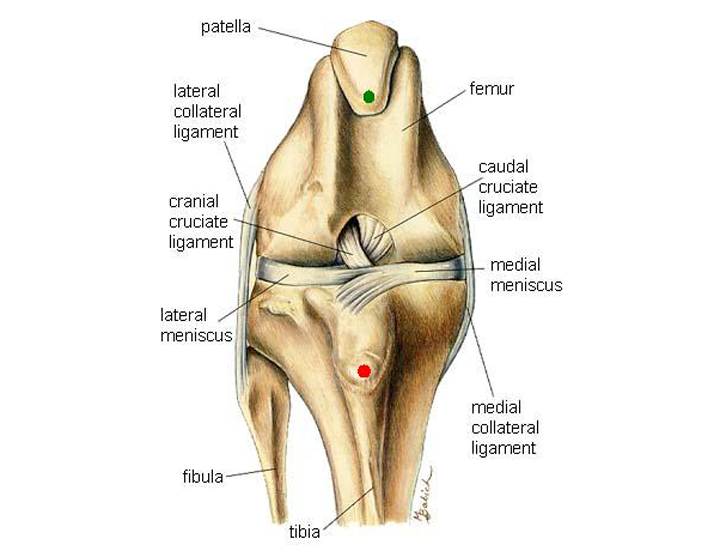Tibial Tuberosity Advancement(TTA) Surgeries
Possibly the BEST Surgery for your dog's Knee
The most common knee injury in dogs is a rupture of the Cranial Cruciate. This injury can occur at any age and in any breed, but most frequently occurs in middle-aged, overweight, medium to large breed dogs. This ligament frequently can suffer a partial tear, leading to slight instability of the knee. If this damage goes untreated, it most commonly leads to complete rupture and possibly damage to the medial meniscus of the knee. The meniscus acts as a cushion in the knee. Complete rupture results in front-to-back instability, commonly called Tibial Thrust, and internal rotation of the lower leg, commonly called Pivot Shift. Untreated legs usually become very arthritic and painful from the instability.
An injured Cruciate Ligament can only be corrected by surgery. There are numerous surgical corrections currently being performed. The most common are:
- External Capsular Repair
- Tibial Plateau Leveling Operation (TPLO)
- Tibial Tuberosity Advancement (TTA)
There are two TTA procedures offered at St. Charles Animal Hospital, one is a newer variance of the original TTA surgical procedure. Your veterinarian will inform you of which one is right for your dog before the surgery.
- TTA Surgical Procedure or TTA2 Surgery
The forces within the knee are very complicated and change as the knee is rotated through its range of motion. In a normal standing position, there is a tendency for the lower end of the Femur to slide backward on the tilted Tibial Plateau, this is called Tibial Thrust. This force can be corrected by either cutting the Tibial Plateau and rotating it into a more flat position (TPLO) or by counteracting this force by changing the angle of pull of the very strong Patellar Tendon by advancing the Tibial Tuberosity (TTA or TTA-2). It has been shown that the TPLO procedure can still allow rotational instability (Pivot Shift) and this may lead to the progression of arthritis as the dog ages. This Pivot Shift does not seem to be a problem with the TTA or the TTA-2 procedure because it results in more control of rotation by the large quadriceps muscle which pulls on the Patellar Tendon.
It has been shown that the TPLO procedure can still allow rotational instability (Pivot Shift) and this may lead to the progression of arthritis as the dog ages. This Pivot Shift does not seem to be a problem with the TTA procedure because it results in more control of rotation by the large quadriceps muscle which pulls on the Patellar Tendon. The differences in physics have been worked out quite well by the researchers. Anyone interested in the details can easily find them by doing an internet search on "TTA vs. TPLO".
The Surgery >
Commonly Asked Questions >
Our Favorite Patients >
Video of the TTA Surgery >
Video of the TTA 2 Surgery >

